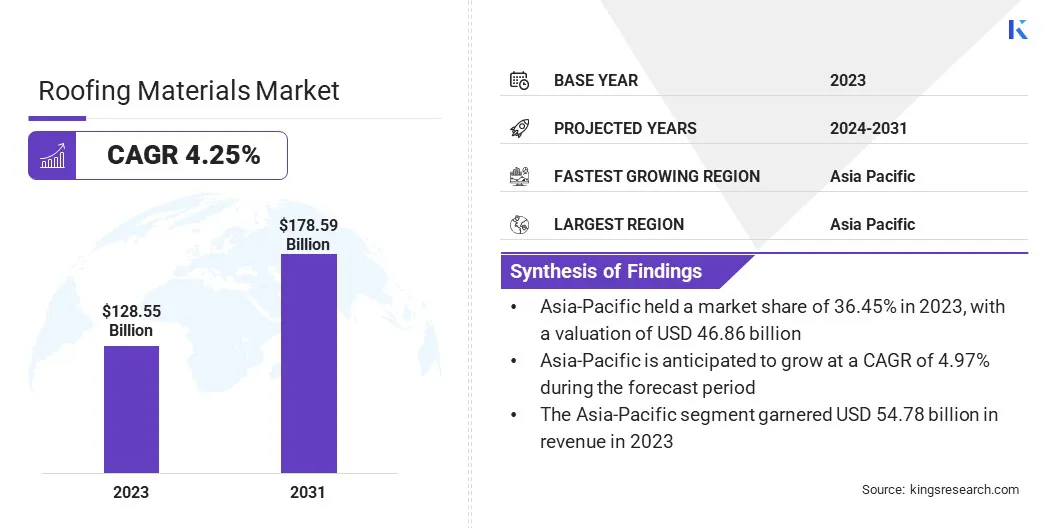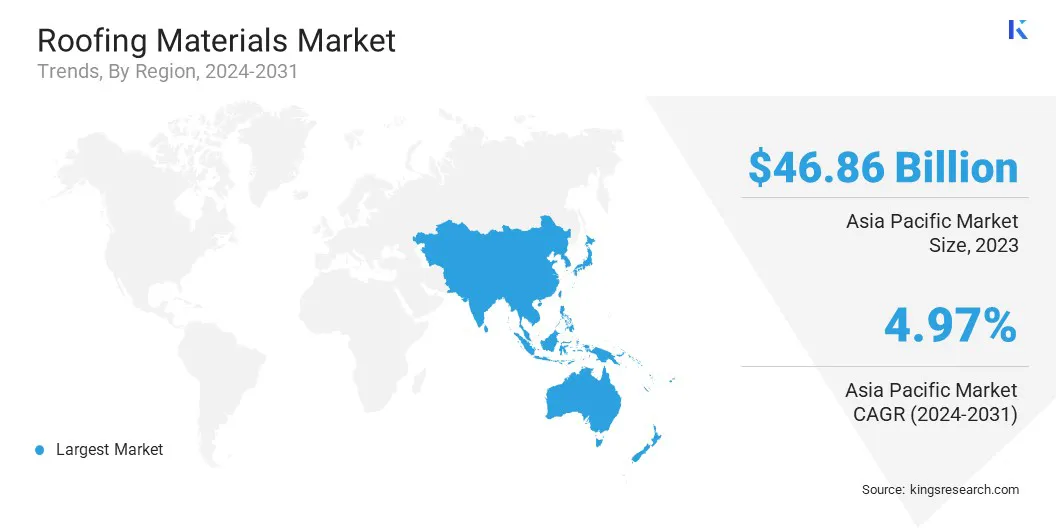Roofing Materials Market Size
The global roofing materials market size was valued at USD 128.55 billion in 2023, and is projected to grow from USD 133.47 billion in 2024 to USD 178.59 billion by 2031, exhibiting a CAGR of 4.25% during the forecast period.
Increased construction and urbanization, particularly in developing economies, fuel the demand for new residential, commercial, and industrial buildings. This growth in infrastructure drives the need for roofing materials, as more buildings require reliable and durable roofing solutions.
In the scope of work, the report includes products offered by companies such as GAF, Inc, Owens Corning, CertainTeed, LLC, Johns Manville (Berkshire Hathaway Company), Wienerberger, Crown Building Products, LLC, Atlas Roofing Corporation , Carlisle Companies Inc., TAMKO Building Products LLC, IKO Industries, Inc, and others.
The roofing materials market is dynamic and evolving, characterized by a diverse range of products for different building types and environmental requirements. It is influenced by global construction activities, technological innovations, and increasing demand for energy-efficient solutions.
The market is highly competitive, with numerous players involved in manufacturing and distributing various materials. Constant advancements in material properties and manufacturing techniques continue to shape the market, creating opportunities for growth & development across various regions.
- In September 2024, Aramco signed a five-year Cooperation Framework Agreement with China National Building Material Group (CNBM) to explore opportunities in advanced materials and industrial development, focusing on low-carbon building materials, manufacturing capabilities, and innovations to drive growth in the roofing sector.
The roofing materials industry refers to the global industry involved in the production, distribution, and sale of materials used for constructing roofs across various types of buildings. It plays a critical role in the construction and infrastructure sectors, providing solutions for protection, durability, and esthetic appeal.
The market caters to diverse requirements, including the need for energy-efficient, weather-resistant, and sustainable roofing options. It is driven by the demand for innovative materials that enhance building performance, contribute to environmental sustainability, and meet regulatory standards. This market spans residential, commercial, institutional and industrial applications, with continual advancements shaping its evolution.

Analyst’s Review
The growing emphasis on energy efficiency and sustainability is reshaping the roofing materials market, with companies adopting strategies to meet the rising demand for eco-friendly solutions. Manufacturers are investing in innovative technologies like solar roofing systems and green roofs to enhance energy performance and reduce environmental impact.
- In October 2024, the City of Boston launched a significant green roof project on 30 bus shelters along the Massachusetts Bay Transportation Authority (MBTA). This initiative incorporates drought-resistant plantings to enhance energy efficiency, improve air quality, support stormwater retention, and contribute to urban sustainability goals.
Additionally, strategic partnerships, research & development, and the introduction of low-carbon materials are becoming key approaches for companies looking to stay competitive. These efforts align with both regulatory demands and consumer preferences for environmentally conscious building solutions.
- In September 2024, Heriot-Watt University initiated a groundbreaking project to explore biochar as a sustainable building material. The interdisciplinary research focuses on reducing carbon emissions in construction, testing biochar’s potential in materials like concrete and brick. The study aims to promote low-carbon building practices and support sustainability and advancements in the construction industry.
Roofing Materials Market Growth Factors
Increased construction and urbanization drive the roofing materials market. The demand for roofing materials grows as cities expand and new buildings are erected, particularly in developing regions. This urban growth fuels the need for a variety of roofing solutions that meet both esthetic and functional requirements, contributing to a continuous rise in market demand.
With the construction of new homes, commercial spaces, and infrastructure projects, roofing materials play a crucial role in supporting these developments.
- According to data from the World Bank Group, approximately 56% of the global population, or 4.4 billion people, currently reside in cities. This urbanization trend is projected to continue, with urban populations expected to more than double by 2050. This rapid urbanization drives the need for more residential, commercial, and industrial buildings, directly fueling the demand for roofing materials to meet the growing infrastructure needs.
Shortage of skilled labor is a significant challenge in the roofing materials market, as it impacts both the quality and speed of installation, potentially slowing down market growth. To address this, companies can invest in training programs and apprenticeships to develop a skilled workforce.
Collaborations with vocational schools and industry organizations can also aid in creating a skilled workforce. Additionally, implementing technologies such as automation and robotics in roofing installation can improve efficiency and reduce reliance on manual labor, ensuring consistent quality and timely project completion.
- In October 2024, CertainTeed partnered with Renovate Robotics to integrate autonomous robots for asphalt shingle installation, addressing the skilled labor shortage in roofing. This collaboration aims to enhance productivity, safety, and efficiency while supporting roofing professionals and responding to growing industry demands.
Roofing Materials Industry Trends
Sustainability and eco-friendly materials are emerging as a key trend in the roofing materials market. Preference for roofing solutions that enhance energy efficiency and minimize environmental impact is increasing. Products like reflective coatings, which reduce heat absorption and improve cooling efficiency, and roofing materials made from recycled content, are gaining popularity.
These sustainable options not only help lower energy consumption but also contribute to reducing waste and promoting eco-friendly construction practices, aligning with the growing demand for green building solutions.
- September 2024: Webasto’s EcoPeak roof concept highlights sustainability in roofing. Utilizing bio-mass balanced and recycled materials, along with integrated solar cells, it reduces weight, enhances energy efficiency, and cuts CO2e emissions by 50%, reflecting the industry's move toward eco-friendly solutions.
Solar roofs and energy-generating roofing systems are rapidly gaining traction in the roofing market. Solar shingles, which combine roofing materials with power generation, are particularly popular as consumers seek energy independence and reduced utility costs.
These innovative systems harness solar energy to generate electricity, making them a highly desirable option for environmentally conscious homeowners and businesses. As energy efficiency becomes a priority, solar roofs are seen as a smart investment that not only reduce energy bills but also contribute to sustainability efforts.
- In October 2024, London Stadium began installing 6,500 square meters of solar membrane panels as part of the LLDC Solar Membrane Project. This energy-generating roof system will produce 850,000 kWh annually, powering major events while reducing carbon emissions by over 200 tonnes, reflecting the rising trend of solar roofs for energy independence and sustainability.
Segmentation Analysis
The global market is segmented based on product type, application, and geography.
By Product Type
Based on product type, the market has been segmented into asphalt shingles, concrete and clay tiles, slate roofing, metal roofing, and others. The asphalt shingles segment led the roofing materials market in 2023, reaching the valuation of USD 54.22 billion. The asphalt shingles segment is registering significant expansion, driven by their affordability, durability, and ease of installation.
Asphalt shingles remain the most widely used roofing material, particularly in residential construction, due to their cost-effectiveness and variety of design options. As homeowners and builders seek versatile and long-lasting roofing solutions, the demand for asphalt shingles continues to rise, especially in emerging markets.
Additionally, advancements in manufacturing technology have led to improved product quality, offering enhanced performance such as better weather resistance and energy efficiency. This expansion reflects broader trends of functional, esthetic, and economical roofing materials.
By Application
Based on application, the market has been classified into residential, commercial, industrial, and institutional. The residential segment secured the largest revenue share of 42.61% in 2023. The residential roofing materials market is registering significant expansion, driven by factors like increased home construction, renovation activities, and growing consumer demand for durable, energy-efficient solutions.
Homeowners are prioritizing sustainable materials such as solar roofing, eco-friendly options, and energy-efficient systems, reflecting a shift toward environmentally conscious choices. Alongside this, advancements in roofing technology, including smart roofing systems and improved weather-resistant materials, are propelling the market.
The rising focus on esthetics, longevity, and energy savings is also driving the demand for high-quality roofing materials. As a result, the residential roofing sector continues to thrive with innovation and sustainability at its core.
Roofing Materials Market Regional Analysis
Based on region, the global market is classified into North America, Europe, Asia Pacific, Middle East & Africa, and Latin America.

Asia Pacific accounted for around 36.45% share of the roofing materials market in 2023, with a valuation of USD 46.86 billion. Asia Pacific is emerging as the dominant market for roofing materials, driven by rapid urbanization, infrastructure development, and a booming construction sector in the region.
Countries like China, India, and Japan are registering significant growth in both residential and commercial building projects, increasing the demand for durable and cost-effective roofing solutions. Additionally, the growing focus on energy efficiency and sustainable building practices is fueling the adoption of eco-friendly roofing materials, such as solar roofs and cool roofing systems.
With a large population base, expanding middle class, and government initiatives supporting infrastructure development, Asia Pacific continues to lead the global market.
The roofing materials market in North America is poised for significant growth over the forecast period at a CAGR of 4.03%. North America is rapidly emerging as one of the fast-growing regions in the market, driven by strong demand for residential, commercial, and industrial roofing solutions.
The region's emphasis on energy efficiency, sustainability, and innovation is accelerating the adoption of advanced roofing materials such as solar shingles, cool roofs, and green roofing systems. Homeowners and businesses are investing in long-lasting, eco-friendly options, due to the increasing awareness about climate change and energy savings.
Furthermore, ongoing construction projects and the growing trend of roof renovations in the U.S. and Canada contribute significantly to the market expansion in the region.
Competitive Landscape
The global roofing materials market report will provide valuable insights with an emphasis on the fragmented nature of the market. Prominent players are focusing on several key business strategies such as partnerships, mergers and acquisitions, product innovations, and joint ventures to expand their product portfolio and increase their market shares across different regions.
Strategic initiatives, including investments in R&D activities, establishment of new manufacturing facilities, and supply chain optimization, could create opportunities for the market growth.
List of Key Companies in Roofing Materials Market
- GAF, Inc
- Owens Corning
- CertainTeed, LLC (Compagnie de Saint-Gobain)
- Johns Manville (Berkshire Hathaway Company)
- Wienerberger
- Crown Building Products, LLC
- Atlas Roofing Corporation
- Carlisle Companies Inc.
- TAMKO Building Products LLC
- IKO Industries, Inc
Key Industry Developments
- January 2024 (Partnership): Omnia Exterior Solutions, a portfolio company of CCMP Growth Advisors, partnered with Ace Roofing, a Montana-based roofing company. Ace Roofing, with nearly 20 years of experience, specializes in large-scale commercial and residential projects. This partnership aims to leverage Omnia's network to support continued growth and innovation..
The global roofing materials market is segmented as:
By Product Type
- Asphalt Shingles
- Concrete and Clay Tiles
- Slate Roofing
- Metal Roofing
- Others
By Application
- Residential
- Commercial
- Industrial
- Institutional
By Region
- North America
- Europe
- France
- UK
- Spain
- Germany
- Italy
- Russia
- Rest of Europe
- Asia Pacific
- China
- Japan
- India
- South Korea
- Rest of Asia Pacific
- Middle East & Africa
- GCC
- North Africa
- South Africa
- Rest of Middle East & Africa
- Latin America
- Brazil
- Argentina
- Rest of Latin America


